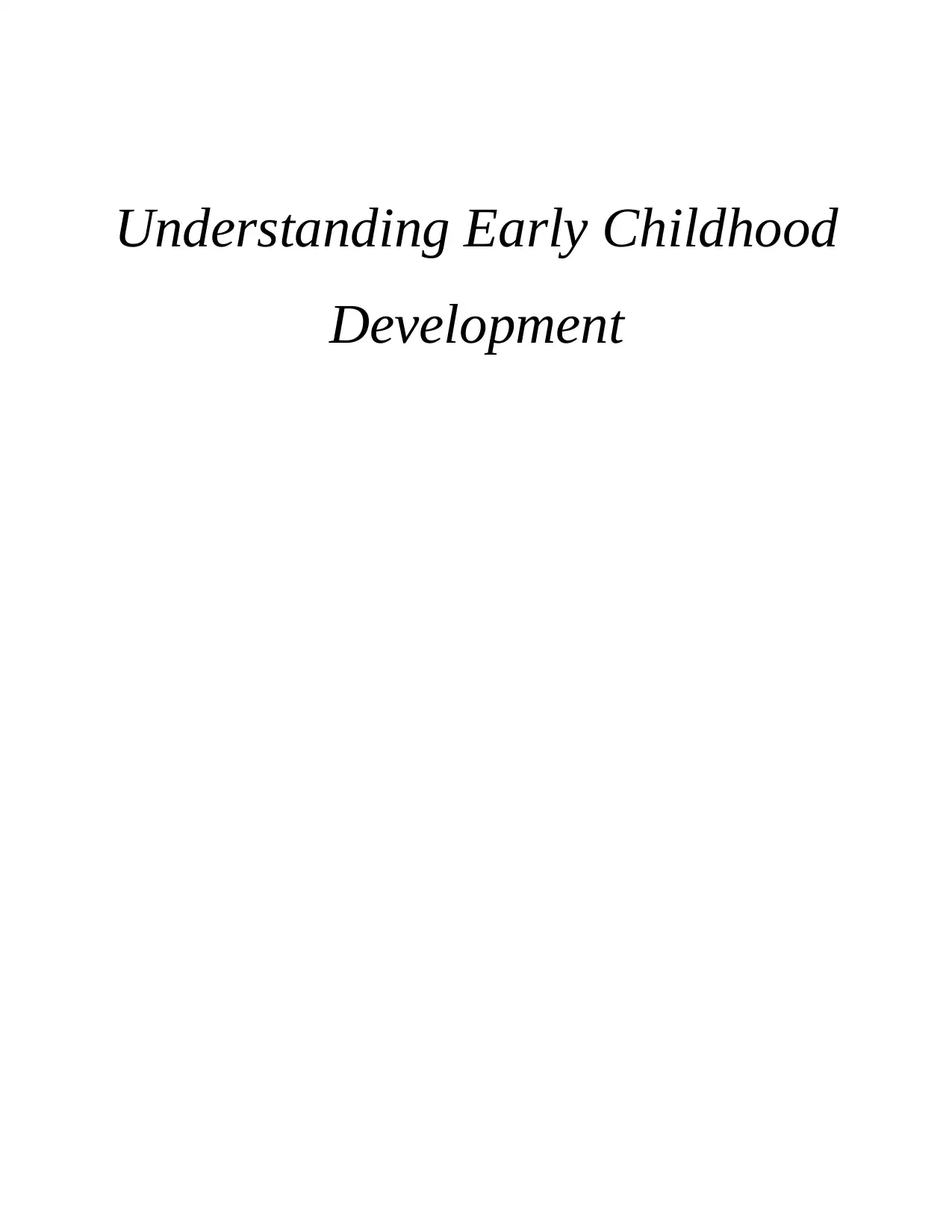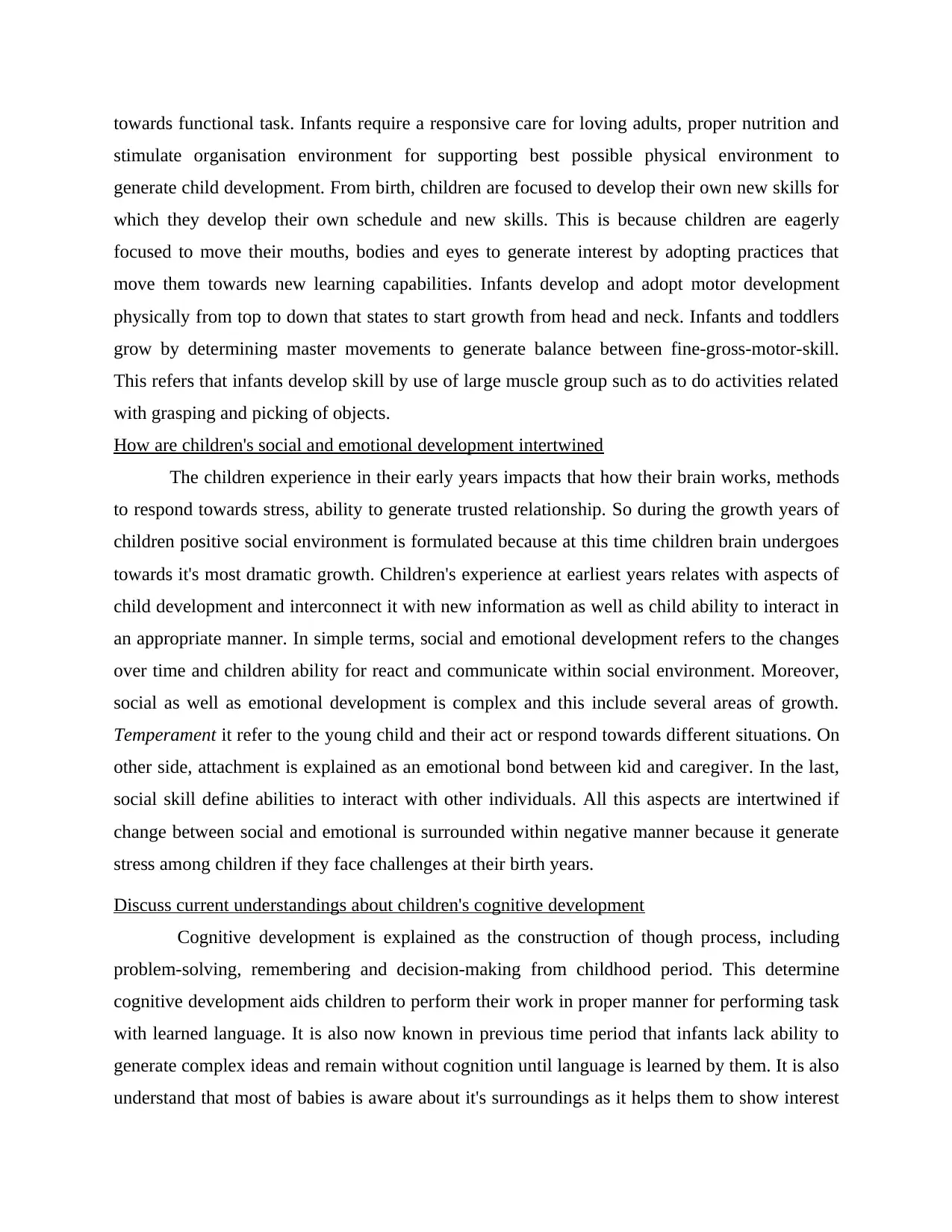Understanding Early Childhood Development: A Comprehensive Report
VerifiedAdded on 2022/12/16
|7
|1446
|1
Report
AI Summary
This report delves into the multifaceted realm of early childhood development, examining key theories and their interconnectedness. It explores the relationship between cultural-historical and bio-ecological theories, providing insights into how children's environments and cultural contexts shape their growth. The report also investigates the physical and motor development of infants and toddlers, highlighting their capabilities and milestones. Furthermore, it discusses the intertwined nature of children's social and emotional development, emphasizing the impact of early experiences. The report also analyzes current understandings of cognitive development, including how children perceive, think, and learn. Finally, it describes the various influences on children's language acquisition, including speech perception, production, and the development of language systems. The report is based on the provided assignment brief and references relevant literature to support its findings.

Understanding Early Childhood
Development
Development
Paraphrase This Document
Need a fresh take? Get an instant paraphrase of this document with our AI Paraphraser

Table of Contents
INTRODUCTION...........................................................................................................................3
MAIN BODY..................................................................................................................................3
Cultural-historical and bio-ecological theories of child development and it's relation with each
other............................................................................................................................................3
Children's physical and motor development in relation to infants and their capabilities...........3
Discuss current understandings about children's cognitive development...................................4
Describe the many influences on children's language acquisition..............................................5
REFERENCES................................................................................................................................6
INTRODUCTION...........................................................................................................................3
MAIN BODY..................................................................................................................................3
Cultural-historical and bio-ecological theories of child development and it's relation with each
other............................................................................................................................................3
Children's physical and motor development in relation to infants and their capabilities...........3
Discuss current understandings about children's cognitive development...................................4
Describe the many influences on children's language acquisition..............................................5
REFERENCES................................................................................................................................6

INTRODUCTION
The term development means to analyse and understand changes in the physical growth
of a children. This also states about changes in children social, communication, behaviour and
emotional skills. All the mention areas of development are linked with each other and they also
influence others by affecting on all stages related with development of children. Moreover, this
report highlights on cultural-historical and bio-ecological theories of child development.
Children physical and motor development that relates with infants and their capabilities will also
included in this report. Development of children on emotional and social and it's understanding
for children's cognitive development is also cover in the upcoming report.
MAIN BODY
Cultural-historical and bio-ecological theories of child development and it's relation with each
other
The theory looks at child's development and in the context of child development, both
culture and bio-ecological theory are related with each other because the ecological theory define
systems of relationship that formulate positive environment at the time of children development.
On the other side, child's development plan is not only based or relate with child but also it
relates with interaction between children and environment. It also determine that culture perform
an important role for development of children because environment system directly relates with
children. Microsystem is the layer closest that relates with child and this contain structure that
directly related with contact. Moreover, microsystem encompasses relationship and interactions
that child has done with their immediate surrounding. The microsystem includes family, school,
childcare and neighbourhood to perform all task in an appropriate manner. Interaction with
structure define all task are managed according to decided level. It define that work is managed
according to both direction that is used for developing child. Another layer which is mesosystem
provide connection between structure of child's microsystem and it connect with child's teacher
and parents that highlights on social system.
Children's physical and motor development in relation to infants and their capabilities
Young children are rapidly enhancing, developing and increasing essential milestones
between birth and age 4. This define when healthy babies are born, some of its internal system,
like all those methods which is developed for processing and breathing food is formulated
The term development means to analyse and understand changes in the physical growth
of a children. This also states about changes in children social, communication, behaviour and
emotional skills. All the mention areas of development are linked with each other and they also
influence others by affecting on all stages related with development of children. Moreover, this
report highlights on cultural-historical and bio-ecological theories of child development.
Children physical and motor development that relates with infants and their capabilities will also
included in this report. Development of children on emotional and social and it's understanding
for children's cognitive development is also cover in the upcoming report.
MAIN BODY
Cultural-historical and bio-ecological theories of child development and it's relation with each
other
The theory looks at child's development and in the context of child development, both
culture and bio-ecological theory are related with each other because the ecological theory define
systems of relationship that formulate positive environment at the time of children development.
On the other side, child's development plan is not only based or relate with child but also it
relates with interaction between children and environment. It also determine that culture perform
an important role for development of children because environment system directly relates with
children. Microsystem is the layer closest that relates with child and this contain structure that
directly related with contact. Moreover, microsystem encompasses relationship and interactions
that child has done with their immediate surrounding. The microsystem includes family, school,
childcare and neighbourhood to perform all task in an appropriate manner. Interaction with
structure define all task are managed according to decided level. It define that work is managed
according to both direction that is used for developing child. Another layer which is mesosystem
provide connection between structure of child's microsystem and it connect with child's teacher
and parents that highlights on social system.
Children's physical and motor development in relation to infants and their capabilities
Young children are rapidly enhancing, developing and increasing essential milestones
between birth and age 4. This define when healthy babies are born, some of its internal system,
like all those methods which is developed for processing and breathing food is formulated
⊘ This is a preview!⊘
Do you want full access?
Subscribe today to unlock all pages.

Trusted by 1+ million students worldwide

towards functional task. Infants require a responsive care for loving adults, proper nutrition and
stimulate organisation environment for supporting best possible physical environment to
generate child development. From birth, children are focused to develop their own new skills for
which they develop their own schedule and new skills. This is because children are eagerly
focused to move their mouths, bodies and eyes to generate interest by adopting practices that
move them towards new learning capabilities. Infants develop and adopt motor development
physically from top to down that states to start growth from head and neck. Infants and toddlers
grow by determining master movements to generate balance between fine-gross-motor-skill.
This refers that infants develop skill by use of large muscle group such as to do activities related
with grasping and picking of objects.
How are children's social and emotional development intertwined
The children experience in their early years impacts that how their brain works, methods
to respond towards stress, ability to generate trusted relationship. So during the growth years of
children positive social environment is formulated because at this time children brain undergoes
towards it's most dramatic growth. Children's experience at earliest years relates with aspects of
child development and interconnect it with new information as well as child ability to interact in
an appropriate manner. In simple terms, social and emotional development refers to the changes
over time and children ability for react and communicate within social environment. Moreover,
social as well as emotional development is complex and this include several areas of growth.
Temperament it refer to the young child and their act or respond towards different situations. On
other side, attachment is explained as an emotional bond between kid and caregiver. In the last,
social skill define abilities to interact with other individuals. All this aspects are intertwined if
change between social and emotional is surrounded within negative manner because it generate
stress among children if they face challenges at their birth years.
Discuss current understandings about children's cognitive development
Cognitive development is explained as the construction of though process, including
problem-solving, remembering and decision-making from childhood period. This determine
cognitive development aids children to perform their work in proper manner for performing task
with learned language. It is also now known in previous time period that infants lack ability to
generate complex ideas and remain without cognition until language is learned by them. It is also
understand that most of babies is aware about it's surroundings as it helps them to show interest
stimulate organisation environment for supporting best possible physical environment to
generate child development. From birth, children are focused to develop their own new skills for
which they develop their own schedule and new skills. This is because children are eagerly
focused to move their mouths, bodies and eyes to generate interest by adopting practices that
move them towards new learning capabilities. Infants develop and adopt motor development
physically from top to down that states to start growth from head and neck. Infants and toddlers
grow by determining master movements to generate balance between fine-gross-motor-skill.
This refers that infants develop skill by use of large muscle group such as to do activities related
with grasping and picking of objects.
How are children's social and emotional development intertwined
The children experience in their early years impacts that how their brain works, methods
to respond towards stress, ability to generate trusted relationship. So during the growth years of
children positive social environment is formulated because at this time children brain undergoes
towards it's most dramatic growth. Children's experience at earliest years relates with aspects of
child development and interconnect it with new information as well as child ability to interact in
an appropriate manner. In simple terms, social and emotional development refers to the changes
over time and children ability for react and communicate within social environment. Moreover,
social as well as emotional development is complex and this include several areas of growth.
Temperament it refer to the young child and their act or respond towards different situations. On
other side, attachment is explained as an emotional bond between kid and caregiver. In the last,
social skill define abilities to interact with other individuals. All this aspects are intertwined if
change between social and emotional is surrounded within negative manner because it generate
stress among children if they face challenges at their birth years.
Discuss current understandings about children's cognitive development
Cognitive development is explained as the construction of though process, including
problem-solving, remembering and decision-making from childhood period. This determine
cognitive development aids children to perform their work in proper manner for performing task
with learned language. It is also now known in previous time period that infants lack ability to
generate complex ideas and remain without cognition until language is learned by them. It is also
understand that most of babies is aware about it's surroundings as it helps them to show interest
Paraphrase This Document
Need a fresh take? Get an instant paraphrase of this document with our AI Paraphraser

with exploration of time in which individuals are born. Further, cognitive development refers
that how a children perceive, think, understand and gain knowledge of it's own world through
use of interaction factors that include genetic and learned factors. This also relates with current
environment which define cognitive development include intelligence test and it is adopted to
understand average intelligence of children for improving learning capabilities of children by use
of different ways that aids person to learn appropriate factors to improve certain behaviour of
children such as to not adopt unethical and negative learning.
Describe the many influences on children's language acquisition
The term language acquisition is explained as a process through which an individual
acquire capacity to perceive and comprehend language. In simple terms, language acquisition
refers to the ability of aware about language and it understanding in order to produce and utilise
words that formulate sentences for communicate. Children's are guided with first-language
acquisition it includes speech perception, speech production and evolve of systems through
which children learn it's language. This improves the brain functions of child by deciding steps
that improves learning methods to learn and transfer all meaningful information in easy manner.
Along with this early observations-based ideas is generated for use of all task that aids to
complete all work by learning capabilities which improve methods to perform work with better
learnings. The capacity to acquire and utilise all language that define key aspect to distinguish all
human from other being. Design features is also founded to manage work with understand
languages that help children for communicating with proper signals.
that how a children perceive, think, understand and gain knowledge of it's own world through
use of interaction factors that include genetic and learned factors. This also relates with current
environment which define cognitive development include intelligence test and it is adopted to
understand average intelligence of children for improving learning capabilities of children by use
of different ways that aids person to learn appropriate factors to improve certain behaviour of
children such as to not adopt unethical and negative learning.
Describe the many influences on children's language acquisition
The term language acquisition is explained as a process through which an individual
acquire capacity to perceive and comprehend language. In simple terms, language acquisition
refers to the ability of aware about language and it understanding in order to produce and utilise
words that formulate sentences for communicate. Children's are guided with first-language
acquisition it includes speech perception, speech production and evolve of systems through
which children learn it's language. This improves the brain functions of child by deciding steps
that improves learning methods to learn and transfer all meaningful information in easy manner.
Along with this early observations-based ideas is generated for use of all task that aids to
complete all work by learning capabilities which improve methods to perform work with better
learnings. The capacity to acquire and utilise all language that define key aspect to distinguish all
human from other being. Design features is also founded to manage work with understand
languages that help children for communicating with proper signals.

REFERENCES
Books and Journals
Aboud, F.E. and Prado, E.L., 2018. Measuring the implementation of early childhood
development programs. Annals of the New York Academy of Sciences, 1419(1),
pp.249-263.
Cline, E.M., 2015. Families of virtue: Confucian and Western views on childhood development.
Columbia University Press.
Radesky, J.S. and Christakis, D.A., 2016. Increased screen time: implications for early childhood
development and behavior. Pediatric Clinics, 63(5), pp.827-839.
Shawar, Y.R. and Shiffman, J., 2017. Generation of global political priority for early childhood
development: the challenges of framing and governance. The Lancet, 389(10064),
pp.119-124.
Shonkoff, J.P., 2017. Breakthrough impacts: What science tells us about supporting early
childhood development. YC Young Children, 72(2), pp.8-16.
Yousafzai, A.K and et. al., 2018. Reporting guidelines for implementation research on nurturing
care interventions designed to promote early childhood development. Annals of the
New York Academy of Sciences, 1419(1), pp.26-37.
(Aboud and Prado, 2018)(Cline, 2015)(Radesky and Christakis, 2016)(Shawar and Shiffman,
2017)(Shonkoff, 2017)(Yousafzai and et. al., 2018)
Books and Journals
Aboud, F.E. and Prado, E.L., 2018. Measuring the implementation of early childhood
development programs. Annals of the New York Academy of Sciences, 1419(1),
pp.249-263.
Cline, E.M., 2015. Families of virtue: Confucian and Western views on childhood development.
Columbia University Press.
Radesky, J.S. and Christakis, D.A., 2016. Increased screen time: implications for early childhood
development and behavior. Pediatric Clinics, 63(5), pp.827-839.
Shawar, Y.R. and Shiffman, J., 2017. Generation of global political priority for early childhood
development: the challenges of framing and governance. The Lancet, 389(10064),
pp.119-124.
Shonkoff, J.P., 2017. Breakthrough impacts: What science tells us about supporting early
childhood development. YC Young Children, 72(2), pp.8-16.
Yousafzai, A.K and et. al., 2018. Reporting guidelines for implementation research on nurturing
care interventions designed to promote early childhood development. Annals of the
New York Academy of Sciences, 1419(1), pp.26-37.
(Aboud and Prado, 2018)(Cline, 2015)(Radesky and Christakis, 2016)(Shawar and Shiffman,
2017)(Shonkoff, 2017)(Yousafzai and et. al., 2018)
⊘ This is a preview!⊘
Do you want full access?
Subscribe today to unlock all pages.

Trusted by 1+ million students worldwide

1 out of 7
Related Documents
Your All-in-One AI-Powered Toolkit for Academic Success.
+13062052269
info@desklib.com
Available 24*7 on WhatsApp / Email
![[object Object]](/_next/static/media/star-bottom.7253800d.svg)
Unlock your academic potential
Copyright © 2020–2025 A2Z Services. All Rights Reserved. Developed and managed by ZUCOL.
![Assessment Task 1: Child Development Report - [University Name]](/_next/image/?url=https%3A%2F%2Fdesklib.com%2Fmedia%2Fimages%2Fmy%2F6becc0b72f9b4358b3d9d5fd9a5b1ed8.jpg&w=256&q=75)


![Ecological Systems Theory and Child Development Essay, [University]](/_next/image/?url=https%3A%2F%2Fdesklib.com%2Fmedia%2Fimages%2Fzr%2Ff9a594fb207243969d0a32ecfd8ad4a4.jpg&w=256&q=75)

